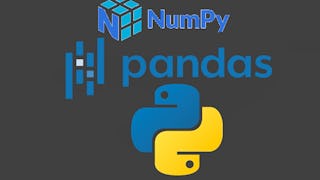How can you effectively use Python to clean, sort, and store data? What are the benefits of using the Pandas library for data science? What best practices can data scientists leverage to better work with multiple types of datasets? In the third course of Data Science Python Foundations Specialization from Duke University, Python users will learn about how Pandas — a common library in Python used for data science — can ease their workflow.



Pandas for Data Science
This course is part of Programming for Python Data Science: Principles to Practice Specialization



Instructors: Genevieve M. Lipp
Access provided by ITC-Infotech
1,779 already enrolled
Recommended experience
Recommended experience
What you'll learn
How and when to leverage the Pandas library for your data science projects
Best practices for cleaning, manipulating, and optimizing data with Pandas
Details to know

Add to your LinkedIn profile
9 assignments
See how employees at top companies are mastering in-demand skills

Build your subject-matter expertise
- Learn new concepts from industry experts
- Gain a foundational understanding of a subject or tool
- Develop job-relevant skills with hands-on projects
- Earn a shareable career certificate


Earn a career certificate
Add this credential to your LinkedIn profile, resume, or CV
Share it on social media and in your performance review

There are 4 modules in this course
This module, you will learn how to read data from files into your python program, and write that corresponding data to a file. We’ll be working primarily with string-type data in this unit and will give special attention to the way that python handles strings. Additionally we’ll go over some basic debugging in python using exception traces, and you’ll leverage these to create your own python program that is capable of reading and writing to a file.
What's included
5 videos7 readings3 assignments3 programming assignments
This module, you’ll learn how to begin to utilize Pandas, one of the most commonly used libraries in Data Science with python. Pandas is predominantly used for working with tabular data. By the end of this module you’ll be able to identify the hallmarks and quirks of working with tabular data, describe the benefits and limitations of using Pandas, and be able to perform some basic data manipulation techniques in Pandas.
What's included
1 video9 readings2 assignments3 ungraded labs
This Module, you will learn how to perform basic file operations in Pandas, as well as how to clean up large datasets. You’ll learn to read and write from common tabular file formats, and Pandas-specific intricacies for working with that data. Additionally, you’ll learn best practices for cleaning your data.
What's included
1 video13 readings3 assignments4 ungraded labs
This module you will learn how to combine datasets from different sources. Pandas has different methods of combining data depending on your preferred outcome, and you’ll be able to differentiate between when to use each kind. Additionally, we’ll go over computationally efficient ways of querying your data, which, while similar to selecting data via subsetting in its outcomes, has a distinct set of advantages.
What's included
1 video11 readings1 assignment5 ungraded labs
Instructors

Offered by
Why people choose Coursera for their career




Explore more from Data Science

Open new doors with Coursera Plus
Unlimited access to 10,000+ world-class courses, hands-on projects, and job-ready certificate programs - all included in your subscription
Advance your career with an online degree
Earn a degree from world-class universities - 100% online
Join over 3,400 global companies that choose Coursera for Business
Upskill your employees to excel in the digital economy










